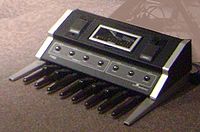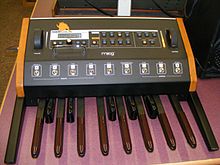- Moog Taurus
-
Taurus Manufactured by Moog Music Dates 1974/1975 - 1981 Technical specifications Polyphony Monophonic Timbrality Non Multitimbral Oscillator 2 Synthesis type Analog subtractive Filter 24dB/Oct Moog low-pass Attenuator ADR envelope Memory 3 preset sounds, 1 variable Effects none Input/output Keyboard 13 pedals Taurus II Manufactured by Moog Music Dates 1981 - 1983 Technical specifications Polyphony Monophonic Oscillator 2 VCO Synthesis type Analog subtractive Filter VCF low-pass Memory none Effects none Input/output Keyboard 18 pedals Left-hand control pitch bend and mod wheels External control CV/Gate outputs The Moog Taurus is a foot-operated analog synthesizer designed and manufactured by Moog Music from 1974[1] or 1975[2] to 1981. Commonly called the Taurus I, it has a 13-note organ-style pedal board similar to the pedal keyboard of a spinet organ.
Contents
History
The Taurus was originally intended to be one-third of a larger synthesizer ensemble called the Constellation that also included two keyboards: The polyphonic Apollo and the monophonic Lyra. This "polyphonic ensemble" was prominently used in prototype form on the Emerson, Lake & Palmer 1973 Brain Salad Surgery album and live during ELP's 1973-1974 World Tour, although the Taurus bass pedal unit was not used by Keith Emerson within this configuration. The 3-part Constellation was never actually released as such; the polyphonic Apollo was greatly refined and ultimately released as the Moog Polymoog Synthesizer; the Lyra - which Keith Emerson's roadie Will Alexander describes as "A Minimoog on steroids", was never commercially produced. Emerson owned the only example ever made of the Constellation. The Taurus pedal synthesizer was released as a self-contained unit, circa 1974[1] or 1975[2].
Design
The Taurus I was housed in a rugged aluminum and wood casing and, although known primarily for its bass timbres, had a five-octave overall range. Three stock preset sounds were available along with one user-programmable Variable sound - the parameters of which were adjustable within a top, centrally located compartment. The three non-variable Presets were named Tuba (single oscillator), Bass, and the famous Taurus. The following parameters were foot switchable: Glide (on/off), Octave (+ 1 octave or Normal), Release (long release on/off), and the three stock Presets and one Variable Preset. Top mounted foot controlled sliders affecting volume (Loudness) and filter cutoff (Filter) were also provided. A unique feature of the Octave function allowed the player to change this footswitch setting while an unpressed note was sounding, with actual transposition only taking place immediately upon the next note press, allowing for smooth, predictable changes during performance and recording. The Taurus I's FET-based integrator oscillator and classic Moog 24dB/Oct Low Pass Filter produce a unique, edgy, penetrating timbre which is not exactly duplicated by any other instrument and is widely regarded for its extremely rich, "fat" sound, which is oftentimes more felt than heard when greatly amplified.
Taurus II
The Taurus I's successor, the Taurus II - essentially a foot-controlled Moog Rogue, which never matched the reputation of its predecessor - was produced from 1981 to 1983. The Taurus II had 18 pedals, modulation and pitch bend wheels, oscillator sync functions and full CV interfacing, but had no footswitch or foot slider control whatsoever and no stock presets, making this instrument much less optimized for live performance use vs. the Taurus I. As a compromise, the control panel on the Taurus II was raised to waist height on a central shaft, to facilitate onstage modification of the settings.
Both the Taurus I and II units have a "low note priority" keying circuit. In the event that the player depresses two notes, the instruments will only sound the lowest pitched note, similar to other monophonic synthesizers. The Taurus I oscillators produced only sawtooth waves; the Taurus II oscillators produced sawtooth, square and preconfigured pulse waves.
Taurus III
By popular demand, Moog Music has designed and is now producing the Taurus III pedal synthesizer, which it reports has a 100% analog audio signal path based entirely on the Taurus I synthesizer circuit. The unit features a greatly expanded feature set including MIDI, USB, more presets, an arpeggiator, a dedicated LFO and velocity sensitive pedals.
Use
Taurus pedals were used by a range of rock, metal, and fusion performers, including Cold Chisel and Michael Jackson on Stacy Lattisaw's 1980 song "You Don't Love Me Anymore", Ritchie Blackmore, Pink Floyd, Neurosis, Electric Light Orchestra, Yngwie Malmsteen, Geddy Lee and Alex Lifeson from Rush, Styx, U2, John Paul Jones from Led Zeppelin, Jon Anderson and Chris Squire from Yes, Sting and Andy Summers of The Police, Mike Rutherford, Steve Hackett & Daryl Stuermer of Genesis, Francis Buchholz of the Scorpions, Justin Harris of Menomena, and Troy Sanders of Mastodon. Genesis drummer Phil Collins brought the Taurus sound to Top 40 radio with his hit single, "I Don't Care Anymore", which features Taurus bass pedals as the sole source of bass in that song.
Ex-Genesis guitarist Steve Hackett had a set mounted waist high which his brother, John Hackett, used to play with his hands for the song Clocks - The Angel Of Mons from the album Spectral Mornings. Adam Jones of Tool (band) uses the Moog Taurus along with an Access Virus B synth to trigger live effects.
Scott Shriner of the band Weezer uses a Taurus to play the bridge bass line of "Surf Wax America" during their live show.
Producer Daniel Lanois uses a Taurus extensively in many projects, one prominent example being the track "I Love You" from his album Shine, and most recently to provide bass notes to accompany Neil Young's guitar playing on Le Noise, which he produced.
Note
- ^ a b Moog proudly introduces... the Taurus Bass Pedal Synthesizer - Available November, 1974 (brochure). moog synthesizers, Norlin Music, Inc.. http://retrosynthads.blogspot.com/2010/08/moog-taurus-bass-pedal-synthesizer-aka.html?utm_source=feedburner&utm_medium=feed&utm_campaign=Feed%3A+RetroSynthAds+%28Retro+Synth+Ads%29&utm_content=Bloglines. — This brochure indicates at least at that time, the Taurus was supposed to be launched as early as 1974, but the result is not sure.
- ^ a b "Chronology 1953-1993". Moog Archives. http://moogarchives.com/chrono.htm. "1975 Moog Music Div of Norlin: ... Release Taurus and Polymoog."
External links
Categories:- Moog synthesizers
Wikimedia Foundation. 2010.


